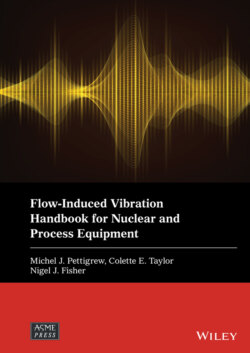Читать книгу Flow-Induced Vibration Handbook for Nuclear and Process Equipment - Группа авторов - Страница 22
2.1.1 Flow‐Induced Vibration Overview
ОглавлениеThe vibration behavior of process system components is governed by vibration excitation mechanisms and by damping mechanisms. Generally, in components such as heat exchangers there are several significant damping mechanisms: 1) friction damping between tube and tube support, 2) squeeze‐film damping at the support, 3) viscous damping between tube and shell‐side fluid, and 4) damping due to two‐phase flow.
Generally, the flow in heat exchanger tube bundles can be parallel (axial flow) or transverse (cross flow) to the tube. In nuclear steam generators, the flow is axial for a large portion of the tube bundle. Vibration excitation forces induced by axial flow are relatively small in heat exchangers. Thus, vibration excitation mechanisms in axial flow may generally be neglected. The vibration behavior is clearly governed by cross‐flow vibration excitation mechanisms.
Several vibration excitation mechanisms are normally considered in heat exchange components such as tube bundles in cross flow, namely: 1) fluidelastic instability, 2) periodic wake shedding, 3) turbulence excitation, and 4) acoustic resonance. Fluidelastic instability is by far the most important mechanism and must be avoided in all cases. Periodic‐wake‐shedding resonance may be of concern in liquid cross flow where the flow is relatively uniform. It is not normally a problem at the entrance region of steam generators because the flow is very non‐uniform and quite turbulent (Pettigrew et al, 1973). Turbulence may inhibit periodic wake shedding in tube arrays. Periodic wake shedding is generally not a problem in two‐phase flow except at very low void fractions (i.e., εg < 15%) or under unusual conditions, as discussed in Chapter 11. Turbulence excitation may be important in liquid cross flow. Periodic wake shedding resonance and turbulence excitation are not usually of concern in gas flow since the fluid density is generally low, thereby resulting in relatively small excitation forces. However, both mechanisms should be considered in some gas heat exchangers such as MSRs where relatively high fluid densities exist. Acoustic resonance must be avoided in heat exchangers with shell‐side gas flow. However, it is generally not a problem in liquid and two‐phase heat exchangers.
